
Do you know the world’s warehouse market was worth $1.01 trillion in 2023, and it’s going to grow by 8.1% each year until 2030? Artificial intelligence (AI) is quickly changing how warehouses are run all around the world. Businesses are using AI to get ahead of the competition because e-commerce and global logistics need speed, accuracy, and cost-effectiveness like never before. AI technologies are making tasks that were thought to be impossible without human oversight easier. These include intelligent automation, predictive analytics, robotics, and computer vision.
In this post, we’ll look closely at how AI is being used in warehouses, including real-life examples, measurable benefits, and genuine deployments by industry experts. This detailed breakdown highlights the power of AI in warehouse management, including the transformative impact of ai in inventory management and ecommerce apis.
Understanding AI in the Context of Warehousing
AI in warehouse management refers to the simulation of human intelligence processes by machines. These systems can perceive environments, reason about optimal decisions, and learn from data to improve over time.
These capabilities enable AI warehouse management systems to operate more efficiently, reduce human error, and meet the growing demands of the modern supply chain.
AI for warehouse management is typically applied using a combination of technologies. Data science in fintech how its changing the game helps predict demand, optimize warehouse layouts, and streamline inventory flows. AI in knowledge base management a complete empowers systems to interpret visual data, enabling automated inspections and object recognition. Robotics and automation allow AI agents to handle picking, sorting, and transporting goods. NLP and IoT generate real-time data that helps AI make accurate decisions instantly.
Detailed Use Cases of AI in Warehouse Management

Intelligent Inventory Management
One of the most important things to do in a warehouse is to keep the right amount of goods. By looking at real-time data from sensors, past trends, market behavior, and customer habits, AI systems can make very accurate predictions about demand. They always keep an eye on the stock, find things that are getting low, and reorder them automatically. Even better, they keep track of how long hazardous items can stay on the shelf and make sure that old items are taken off the shelf before they reach the customer. Being able to see ahead of time cuts down on waste, keeps you from running out of stock, and makes sure customers are happy.
Robotic Picking and Sorting
The order fulfillment process requires precision and speed. AI agents in logistics help automate the picking and sorting process through robotic arms and automated guided vehicles. These intelligent machines identify items based on visual and textual cues, pick them with accuracy, and deliver them to the correct packing stations. Advanced vision systems detect item orientation and packaging types to ensure products are handled safely. As these machines learn from each cycle, their efficiency and accuracy increase significantly, creating a seamless fulfillment workflow. These systems enhance picking efficiency, similar to intelligent use cases covered under ai in real estate examples.
Predictive Maintenance
Warehouse equipment such as conveyor belts, robotic arms, and sorting systems are vital to continuous operations. Unexpected breakdowns can halt processes and cause major delays. AI uses data from sensors embedded in machines to detect anomalies, such as changes in vibration or heat, which might indicate an impending failure. Machine learning models analyze this data, predict when a component will fail, and schedule maintenance accordingly. This approach ensures that maintenance is performed only when needed, reducing downtime and repair costs.
Warehouse Layout Optimization
AI for warehouse management is particularly effective in designing efficient warehouse layouts. AI systems track the movement of goods and workers to identify traffic bottlenecks and unnecessary walking distances. Based on data patterns, AI recommends optimal product placements, with high-frequency items placed near shipping zones. It also simulates different layout scenarios to find the best design before implementing changes in the physical space. This continuous improvement reduces travel time, boosts worker productivity, and enhances overall warehouse flow. Optimization strategies align with frameworks like reasons to choose next js, where system design efficiency is key.
Demand Forecasting and Replenishment
Machine learning for warehouse management enables precise forecasting by analyzing historical sales data, promotional campaigns, seasonal demand fluctuations, and external variables like weather and holidays. The AI system not only forecasts demand but also generates proactive replenishment plans to ensure optimal stock levels at all times. By aligning procurement an
d replenishment with actual consumer behavior, warehouses can minimize overstocking and understocking, reducing costs and improving service levels.
Quality Control with Computer Vision
AI warehouse management systems incorporate computer vision technology to inspect products automatically. These systems scan packages for damages, incorrect labeling, and missing components. The AI learns over time what constitutes an acceptable product and flags any deviation. This inspection process happens at scale without interrupting the flow of operations, ensuring consistent quality control with minimal human involvement.
Real-Time Location Tracking
Tracking inventory, tools, and equipment within a warehouse is a challenge, especially in large facilities. AI for warehouse management integrates GPS, RFID, and sensor technologies to offer real-time location tracking. These AI agents monitor the movement of goods, optimize equipment routes, and provide visibility into asset usage. This leads to better space utilization and efficient resource deployment, as managers can identify idle equipment or congestion points instantly.
Workforce Optimization
While automation plays a key role, human labor remains essential in many warehouses. AI in warehouse management helps optimize workforce o
perations by forecasting workload and aligning staffing accordingly. AI systems analyze performance data to assess individual productivity, recommend shift patterns, and schedule training. Some systems even integrate with wearable devices to detect fatigue, monitor ergonomics, and enhance worker safety. These capabilities make workforce management more data-driven and efficient.
Measurable Benefits of AI in Warehouse Management

Operational Efficiency
AI warehouse management systems significantly improve operational efficiency. Automated picking, real-time data visibility, and optimized layouts reduce cycle times and bottlenecks. Processes that once took hours can now be completed in minutes.
Cost Reduction
AI agents in ecommerce and logistics bring substantial cost savings. Predictive maintenance reduces repair expenses. Inventory optimization lowers holding costs. Smart labor management decreases overtime. All these factors contribute to leaner operations.
Higher Accuracy and Fewer Errors
Automation and AI reduce human error. From inventory counts to order picking, AI systems deliver greater accuracy. Computer vision ensures product quality, and data-driven decision-making reduces inconsistencies.
Increased Safety
AI robots can handle heavy and hazardous tasks. AI-driven safety monitoring detects unsafe behaviors in real-time and provides alerts. This reduces accidents and creates a safer work environment.
Enhanced Customer Satisfaction
By ensuring product availability, faster delivery, and fewer errors, AI systems improve customer satisfaction. This leads to repeat business, positive reviews, and stronger brand loyalty.
Bonus read: How to use AI agents for data analysis
Real-World Deployments and Case Studies
Amazon operates over 750,000 robots in its fulfillment centers. These AI agents in logistics autonomously navigate the warehouse floor, retrieve shelves, and assist human workers. Their systems are driven by advanced machine learning models that optimize order fulfillment in real time.
JD.com’s fully automated warehouse in Shanghai is another powerful example. Using AI-powered robotic arms, AGVs, and vision systems, this facility processes nearly 200,000 orders per day with minimal human intervention. It represents one of the most advanced deployments of AI in warehouse management.
PepsiCo has implemented AI-based demand planning systems across its global warehouses. These systems use sales data, marketing campaigns, and external factors to forecast product needs, reducing stock-outs by 30% and waste by 12%.
Siemens employs predictive maintenance systems powered by machine learning for warehouse machinery. Sensors monitor equipment in real time, enabling AI to detect early signs of malfunction and plan maintenance, preventing operational disruptions.
Challenges in Adopting AI in Warehousing
Using AI to run a warehouse has its benefits, but it also has its problems. The high costs of implementation are a big problem, especially for small and medium-sized organizations. These investments include training, upgrading equipment, and services for developing AI.
Another problem is data integration. Many warehouses still utilize old technologies that don’t work with newer AI tools. AI can’t work well without good data.
Resistance from workers to using AI might also slow down development. Employees may be afraid that automation may take their employment. This is why it’s important to offer change management and reskilling programs together with AI agent creation services.
As more gadgets and systems connect to networks, the vulnerabilities to cybersecurity are getting worse. Data leaks, malware, and illegal access must be kept away from AI systems.
The Future of AI in Warehouse Management
AI warehouse management is becoming more self-sufficient, predictive, and connected in the future. AI agents in logistics will work together more, learn from each other, and change based on real-time data. Digital twins, which are virtual copies of real warehouses, will let managers try out changes before they make them.
Sustainability will also be very important. AI will help save energy, make packaging better, and cut down on emissions from transportation. AI agents in ecommerce will go beyond warehouses to include last-mile delivery and customer service.
As AI development services and AI agent development services continue to improve, organizations of all sizes will be able to adopt scalable, adaptable warehouse solutions that make them more efficient and profitable.
Conclusion
AI in warehouse management is no longer a thing of the future; it’s a must-have for businesses today. Companies that employ AI warehouse management systems are more efficient, spend less money, and get more accurate results in all of their work. The power of AI for warehouse management is changing the way logistics works, whether it’s through robotic automation, predictive analytics, or smart workforce planning.
AI Agents In Logistics and AI Agents In Ecommerce are examples of how integrated, smart systems may make a big difference. Companies that want to grow and compete in a market that moves quickly should invest in AI development services and AI agent development services to stay ahead of the game.
Ready to optimize your warehouse operations with AI? Let Appic Softwares help you build intelligent, future-ready AI agent solutions. Contact us today and take the first step toward smart warehouse management!
FAQs
1. What is AI in Inventory Management and how does it improve warehouse operations?
AI in Inventory Management leverages artificial intelligence to monitor inventory levels, detect demand patterns, and automate stock replenishment. In warehouse operations, it streamlines workflows by predicting stock requirements in advance, reducing human errors, and improving space utilization. Ultimately, this enhances operational efficiency and ensures timely delivery to customers, even during peak demand. This approach has become even more valuable as businesses navigate hybrid and remote operations, where coordination is key—similar to practices outlined in succeeding in remote project management.
2. How does AI help with warehouse workforce and resource planning?
Artificial Intelligence supports workforce planning by using predictive analytics and historical data to anticipate workload surges. This ensures optimal staffing and reduces labor costs. The application of AI in CRM shows how intelligent automation improves customer relationship management—similarly, in warehouses, AI enhances team productivity by assigning tasks based on efficiency, availability, and urgency.
3. Can AI improve decision-making in real-time logistics management?
Yes, AI is really important for making judgments in real time, especially when it comes to logistics and last-mile deliveries. Algorithms look at real-time traffic, weather, and order data to find the best routes and avoid delays. Machine Learning in Finance ideas can be used here. Just like ML models can predict financial risks, they can also predict delivery delays, vehicle maintenance needs, and route performance to make warehouse logistics run more smoothly.








